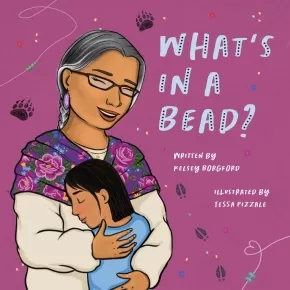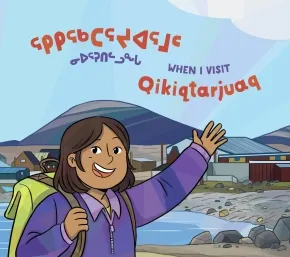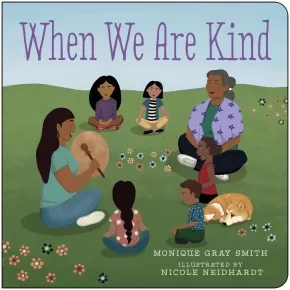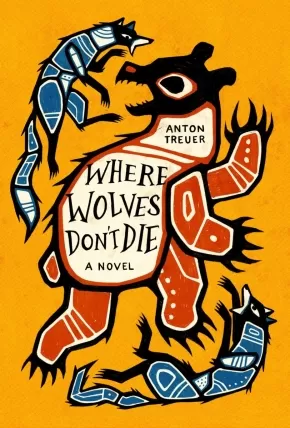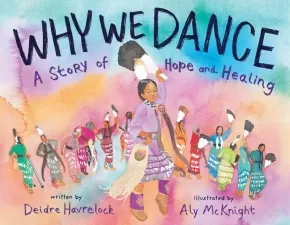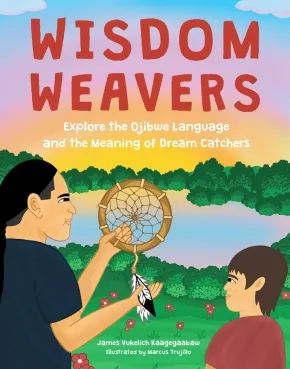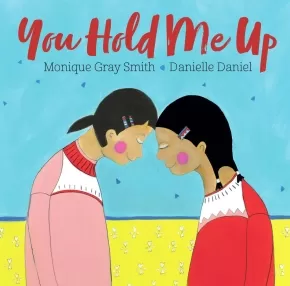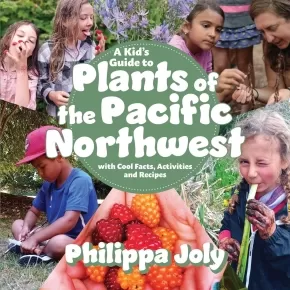
Indigenous Peoples
391
-
405
of
1573 Results;
Sort By
Go To
of 105
What's in a Bead?
$21.95
Artists:
Text Content Territories:
Indigenous Canadian; First Nations; Anishinaabeg; Cree (Nehiyawak);
ISBN / Barcode: 9781772603668
Synopsis:
Synopsis:
There are many stories in a bead. We must listen to the stories they tell us.
Tessa loves how her grandmother always smells of campfire stories. Mom says it’s because Kohkom spends her days sewing beautiful beads onto smoked hides. Inspired, Tessa asks Kohkom to teach her beading, but first she must listen and learn about the many stories held in a bead.
A celebration of Cree craftsmanship, language, and learning. The loving exchange of knowledge between Tessa and her Kohkom will be familiar to many children. Readers will learn that different Indigenous communities have different beadwork techniques, and that this traditional art form is alive and thriving today.
Reviews
"The story is a beautiful look into the importance of beading in our communities and the ways that this art practice ties us together as families and communities." — Nancy Cooper, First Nations Consultant for the Southern Ontario Library Services and coordinator for First Nation Communities Read
Educator Information
Recommended for ages 6 to 8.
A dual-language version in Ininîmowin (Cree, N-dialect) and English is available: kekwan etakwak mîkisîhk / What’s in a Bead?
Additional Information
24 pages | 8.50" x 8.50" | Hardcover
When I Visit Qikiqtarjuaq
$16.95
Artists:
Format:
Paperback
Text Content Territories:
Indigenous Canadian; Inuit;
Grade Levels: Preschool; Kindergarten;
ISBN / Barcode: 9781774508053
Synopsis:
Synopsis:
"There are many things I would like to do and see with my friend in Qikiqtarjuaq."
Monica wants to visit her friend Mary in Qikiqtarjuaq, Nunavut. Monica likes to imagine all the fun they will have together there. Monica and Mary will go camping, fish for delicious Arctic char, and see the big icebergs around the community. There will be lots to do when Monica visits Qikiqtarjuaq in this bilingual picture book!
Educator & Series Information
Recommended for ages 3 to 5.
Dual-Language: English and Inuktitut.
This book is part of the Community Connections series.
Additional Information
19 pages | 8.00" x 9.00" | Paperback
When We Are Kind (BB)
$12.95
Artists:
Format:
Board Book
Text Content Territories:
Indigenous American; Indigenous Canadian;
Grade Levels: Preschool;
ISBN / Barcode: 9781459836372
Synopsis:
Synopsis:
When We Are Kind celebrates simple acts of everyday kindness and encourages children to explore how they feel when they initiate and receive acts of kindness in their lives. Celebrated author Monique Gray Smith has written many books on the topics of resilience and reconciliation, and she communicates an important message here for readers of all ages through her carefully chosen words. Beautifully illustrated by artist Nicole Neidhardt, this book encourages children to be kind to others and to themselves.
Reviews
“Notably centering Indigenous families and characters of color in personal and communal activities—and encouraging readers to evaluate their actions toward others.” —Publishers Weekly
Educator Information
Recommended for ages 2 and under.
Themes: Teaching Compassion, Being Kind, Family, Friendship, Gratitude
This book is also available in hardcover format: When We Are Kind
This book is also available in a dual-language hardcover format: When We Are Kind / Nihá’ádaahwiinít’íįgo
This book is also available in French: Nous sommes gentils
Additional Information
32 pages | 9.00" x 9.00" | Board Book
When We Gather (Ostadahlisiha): A Cherokee Tribal Feast
$24.99
Artists:
Format:
Hardcover
Text Content Territories:
Indigenous American; Native American; Cherokee;
ISBN / Barcode: 9780063076792
Synopsis:
Synopsis:
Nothing welcomes spring like a wild onion dinner!
As the dirt warms and green sprouts poke up, a Cherokee girl joins her family in the hunt for green onions. Together, they pick enough to bring to a feast, which is cooked with love and shared by their community.
Idalisdayvhvga!
Let’s all eat!
Written with simple, sensory lyricism by Andrea Rogers (Cherokee) and featuring warm, vibrant art by Madelyn Goodnight (Chickasaw), this picture book celebrates the spring tradition of wild onion dinners—and the community and comfort that are shared when we gather.
Educator Information
Recommended for ages 4 to 8.
Additional Information
40 pages | 8.00" x 10.00" | Hardcover
Where Wolves Don't Die: A Novel
$28.99
Format:
Hardcover
Text Content Territories:
Indigenous Canadian; First Nations; Anishinaabeg; Ojibway; Saulteaux; Nigigoonsiminikaaning First Nation;
ISBN / Barcode: 9781646143818
Synopsis:
Synopsis:
Ezra Cloud hates living in Northeast Minneapolis. His father is a professor of their language, Ojibwe, at a local college, so they have to be there. But Ezra hates the dirty, polluted snow around them. He hates being away from the rez at Nigigoonsiminikaaning First Nation. And he hates the local bully in his neighborhood, Matt Schroeder, who terrorizes Ezra and his friend Nora George.
Ezra gets into a terrible fight with Matt at school defending Nora, and that same night, Matt’s house burns down. Instantly, Ezra becomes a prime suspect. Knowing he won’t get a fair deal, and knowing his innocence, Ezra’s family sends him away to run traplines with his grandfather in a remote part of Canada, while the investigation is ongoing. But the Schroeders are looking for him…
From acclaimed author Anton Treuer comes a novel that’s both taut thriller and a raw, tender coming-of-age story, about one Ojibwe boy learning to love himself through the love of his family around him.
Reviews
“Where Wolves Don't Die will lift you up and not let you down. Anton Treuer knows how to tell a gripping story and the suspense doesn't let up for a single page. Along the way you'll learn about Ojibwe lifeways, languages, sharp jokes, gentle humor, and how to keep romantic love alive from youth to old age. I couldn't put this book down until I'd finished it, and then, I could not forget it.”—Louise Erdrich, Pulitzer Prize winner and owner of Birchbark Books
“I am in awe, crying and smiling at the same time. Where Wolves Don’t Die is a love letter to our Ancestors.”—Angeline Boulley
“Treuer immerses the reader in Ojibwe culture in this suspenseful novel of wilderness survival… An essential illumination of contemporary Indigenous life.”—Booklist
Educator Information
Recommended for ages 12 to 18.
Set in the Canadian wilderness, Where Wolves Don't Die is a thrilling YA coming-of-age novel that has garnered praise from Angeline Boulley, Booklist, and more. A suspenseful adventure tale for teens.
Additional Information
256 pages | 5.50" x 8.25" | Hardcover
Who Will Win? (PB)
$11.99
Format:
Paperback
Text Content Territories:
Indigenous Canadian; First Nations; Haudenosaunee (Iroquois); Kanyen'keha:ka (Mohawk); Akwesasne;
ISBN / Barcode: 9780823456949
Synopsis:
Synopsis:
Bear has fast legs. Turtle has a fast mind. Who will win the race? A fun Indigenous story that kindergarteners and first graders can read on their own.
Ready, set, go!
Bear will go over the ice.
Turtle will go under the ice.
Bear runs fast.
But where is Turtle?
When a quick-footed bear and a quick-witted turtle race across a frozen lake, Turtle has a secret plan to win!
Reviews
"With just a few words per page, presented in a large font, and visuals that reflect the action, this one is ideal for beginning readers. Exaggerated, energetic cartoon illustrations enhance the easy-to-read text. Children will be charmed by the humor, drama, fun twist, and wonderfully entertaining characters. The characters’ strengths and savvy will delight emerging readers."—Kirkus Reviews
"This clever tale should find a place in most collections, especially given the lack of Indigenous voices and representation in the beginning reader format."—School Library Journal
Educator & Series Information
Written and illustrated by Mohawk author-illustrator Arihhonni David, this easy reader based on an Indigenous tale combines exciting storytelling and easy-to-read language.
This book has been officially leveled by using the Fountas & Pinnell Text Level Gradient leveling system. It is a Level G.
This book is a guided reader based upon Fountas and Pinnell standards.
High-quality illustrations support comprehension of simple text. Fun for kids to read again and again with their parents, teachers, or on their own!
This book is part of the I Like to Read series.
Additional Information
32 pages | 7.78" x 9.99" | Paperback
Why We Dance: A Story of Hope and Healing
$23.99
Artists:
Format:
Hardcover
Text Content Territories:
Indigenous American; Indigenous Canadian;
ISBN / Barcode: 9781419756672
Synopsis:
Synopsis:
From Indigenous creative team Deidre Havrelock and Aly McKnight comes a powerful and exuberant story about the heritage, joy, and healing power of the Jingle Dress Dance—a perfect read-aloud picture book.
It’s a special day—the day of the Jingle Dress Dance! Before the big powwow, there’s a lot to do: getting dressed, braiding hair, packing lunches, and practicing bounce-steps. But one young girl gets butterflies in her stomach thinking about performing in front of her whole community. When the drumbeats begin, though, her family soothes her nerves and reminds her why she dances.
Emerging historically in response to the global influenza pandemic of 1918–19, the Jingle Dress Dance is a ceremonial dance of healing and prayer that still thrives today in many Indigenous and First Nations communities across North America. Lyrically and rhythmically written with lush, full-color illustrations, Why We Dance is a joyous celebration of a proud Indigenous tradition that inspires hope, resilience, and unity.
Educator Information
Recommended for ages 4 to 8.
Additional Information
40 pages | 11.00" x 8.50"| Hardcover
Wings of an Eagle: The Gold Medal Dreams of Billy Mills
$25.99
Artists:
Format:
Hardcover
Text Content Territories:
Indigenous American; Native American; Sioux; Lakota; Oglala Lakota; Pine Ridge Indian Reservation;
ISBN / Barcode: 9780316373487
Synopsis:
Synopsis:
Just in time for the 2024 Summer Olympics, here is a dramatic and inspiring autobiographical tale of overcoming odds by Native American gold medalist Billy Mills, with stunning illustrations by acclaimed Lakota artist SD Nelson.
Billy Mills was once an orphan on the Oglala Lakota Pine Ridge Reservation. But before his father was called to the ancestors, he told Billy how to conquer his suffering: You have broken wings, son. You have to dig deeper, below the anger, the hurt, the self-pity. The pursuit of a dream will heal you.
Despite poverty, racism, and severe health challenges, Billy raced toward his goal of becoming an Olympic athlete, inspired by his indigenous ancestors who stood strong when the odds were against them. Though at times he felt like his wings were clipped—a lone bird falling from the sky—he adapted and overcame, finally earning his place at the 1964 Olympics.
Educator Information
Recommended for ages 4 to 8.
This autobiographical tale of Billy Mills’s awe-inspiring flight to a record-breaking gold medal, breathtakingly illustrated by award-winning Lakota artist SD Nelson, is a soaring testament to Billy’s legacy and the Lakota prayer: we are all related.
Additional Information
48 pages | 10.00" x 10.00"| Hardcover
Wisdom Weavers: Explore the Ojibwe Language and the Meaning of Dream Catchers
$25.99
Artists:
Format:
Hardcover
Text Content Territories:
Indigenous American; Native American; Anishinaabeg; Ojibwe (Chippewa);
ISBN / Barcode: 9780760387191
Synopsis:
Synopsis:
Follow a day in the life of a young, mixed heritage Ojibwe child and learn key words and phrases from the Ojibwe language in this enchantingly illustrated children’s book.
The Ojibwe people are the largest Indigenous group of Turtle Island, now known as North America, and live around the present-day Great Lakes. After their land was taken by Europeans, many Ojibwe children were placed in boarding schools that forbid them to use their native language. Though this led to a decline in fluent speakers, there is a growing movement to restore the strength of the Ojibwe language.
In Ojibwe culture, a dream catcher (izhi’on) protects people, especially children, from harm by catching bad dreams in its web and allowing good dreams to pass through the feathers hanging at the bottom.
Wisdom Weavers introduces children to the Ojibwe language from an Indigenous perspective. International speaker, author, and creator of Ojibwe Word of the Day, James Vukelich Kaagegaabaw, presents a selection of words and phrases throughout the day while his son learns about the Ojibwe tradition of the dream catcher. Created with children ages 6 to 11 (beginner- to mid-level readers) in mind, Wisdom Weavers is an engaging and accessible way for children to discover the Ojibwe language and learn key phrases and words like:
How to welcome the morning - Mino-giizhigad
How to say I love you - Gizhawenimin
How to be grateful - Miigwech
How to make an offering - Biindaakoojige
School - Gikinoo’amaadiiwigamig
Tree - Mitig
Backpack -Bimiwanaan
Sun - Giizis
And more!
This inspiring story features a total of 73 words and phrases to learn in Ojibwe, introduced throughout the visually captivating and representative scenes showing an average day in an Ojibwe family from illustrator Marcus Trujillo, a tribal member with the Pueblo of Laguna in affiliation with the Village of Paraje. Also featuring a brief history of the Ojibwe people and language and a culturally accurate how-to guide for making a dream catcher at home, Wisdom Weavers immerses young people in a vibrant traditional culture while helping to keep the Ojibwe language and customs alive.
Educator Information
Recommended for ages 6 to 11.
This book includes some words and phrases in Ojibwe, but it is not a fully dual-language book.
Additional Information
32 pages | 8.50" x 11.00" | Hardcover
You Are Not Alone
$19.95
Artists:
Format:
Paperback
Text Content Territories:
Indigenous Canadian; Inuit;
ISBN / Barcode: 9781772312287
Synopsis:
Synopsis:
You Are Not Alone is an illustrated children's book about growing up in the North as an Inuit child and looking for friends. This book is a debut collaboration between Tagiuk Ikkidluak, an emerging Inuit author and Arnaq Pitsiulak, an Inuit artist and illustrator.
Educator Information
Recommended for ages 4 to 8.
Additional Information
26 pages | 8.00" x 8.00" | Paperback
You Are the Land
 $18.95
$18.95

Artists:
Format:
Hardcover
Text Content Territories:
Indigenous Canadian; First Nations; Anishinaabeg;
ISBN / Barcode: 9781771746328
Synopsis:
Synopsis:
Inspired by the Physical quadrant of the Anishinaabe Medicine Wheel, You Are the Land reminds young readers that they are a part of the world around them. With fun, rhyming text, each page compares our physical bodies to plants, animals, and the four elements, sharing an important message: You are the Land.
From the author of You Are Sacred, this is the second book in the All That You Are series.
Awards
- 2025-2026 First Nation Communities READ Award Longlisted
Educator Information
You Are the Land is a perfect read-aloud for children ages 3 to 6 in both classrooms and homes.
Curriculum Connections:
Early Literacy – listening, reading, discussing, and rhyming
Art – traditional Anishinaabe clothing and art
Health and Wellness – breath and balance, self-affirmation, connection to nature for physical health and wellness, and traditional medicines
Science – harmonious ecosystems, biodiversity of plants and animals with Indigenous cultural importance, environmental awareness
Social Responsibility – uplifting others and ourselves, respecting Mother Earth
Indigenous Knowledge and Traditions – teachings of the Anishinaabe Medicine Wheel, the Seven Generations, the Three Sisters, and All Our Relations
Series Information
You Are the Land is the second book in the All That You Are series. Through lyrical text and colourful watercolour illustrations, the All That You Are series uses the teachings of the Anishinaabe Medicine Wheel to remind children of their connection to the world around them. Each book in the series focuses on one quadrant of the Medicine Wheel representing one kind of wellness—Spiritual, Physical, Emotional, or Mental. A diagram and description of the Medicine Wheel are included at the back of each book. Also included are Anishinaabe Connections, which share more about Anishinaabe art, culture, and traditions explored in the text and illustrations. Books in the All That You Are series are best suited for children ages 3 to 6 and make wonderful read-alouds in classrooms and homes.
You Are Sacred is the first book in the series.
A percentage of proceeds from the All That You Are series is donated to the Indian Residential School Survivors Society to support their efforts in advocacy for justice and healing. To find out more information, please visit https://www.irsss.ca/.
Additional Information
24 Pages | 8" x 8" | Hardcover | ISBN: 978-1-77174-632-8
You Hold Me Up (BB)
$12.95
Artists:
Format:
Board Book
Text Content Territories:
Indigenous Canadian;
Grade Levels: Preschool;
ISBN / Barcode: 9781459836389
Synopsis:
Synopsis:
Encourage children to show love and support for each other and to consider each other’s well-being in their everyday actions.
Award-winning author and international speaker Monique Gray Smith wrote You Hold Me Up to prompt a dialogue among young people, their care providers and educators about reconciliation and the importance of the connections children make with others. With vibrant illustrations from award-winning author and illustrator Danielle Daniel, this is a foundational book about building relationships, fostering empathy and encouraging respect between peers, starting with our littlest citizens.
Educator Information
This board book version of You Hold Me Up is recommended for ages 2 and under.
This book is available in hardcover: You Hold Me Up
This book is available in English and Plains Cree: You Hold Me Up / ê-ohpinitoyahk
This book is available in English and Anishinaabemowin: You Hold Me Up / Gimanaadenim
This book is also available in French: Tu es là pour moi
Additional Information
24 pages | 7.00" x 7.00" | Board Book
ON SALE - Strong Science - Animals: The Ducks Fly Away
 $6.38 $7.50
$6.38 $7.50

Artists:
Format:
Paperback
Text Content Territories:
Indigenous Canadian;
Grade Levels: Kindergarten; 1;
ISBN / Barcode: 978-1-77174-617-5
Synopsis:
Synopsis:
This story begins with the ducks seeing the leaves on the trees turning red and yellow. How do you think this story ends?
There are four seasons in the year: winter, spring, summer, and fall. Which season is this story about?
Educator & Series Information
Recommended for grade 1 students, but may also be useful in kindergarten classrooms.
Strong Science - Animals is a language-based science series for primary students featuring animals that all Canadian students will recognize. Photographs and Indigenous artwork illustrate the series. Common learning objectives in science curricula across Canada are addressed, and suggestions for extending the learning to other curriculum areas, including Indigenous cultural awareness, language arts, math, and art, are included in the teacher’s guide. The sixteen books in this series are grouped into four levels that increase in complexity, designed to accommodate students with various reading abilities within a classroom. This feature facilitates the use of this series in literacy programs along with the Strong Readers series.
The Ducks Fly Away is an EP3 (Early Primary 3) book in the Strong Science - Animals series. Font size decreases as language complexity and word count increase across levels: EP1 books have approximately 40 words, EP2 books have approximately 60 words, EP3 books have approximately 80 words, and EP4 books have approximately 100 words.
A teacher's guide for Strong Science - Animals is available: Strong Science - Animals: Teacher's Guide
Authenticity Note: This book has received the Indigenous Text label because the author is Indigenous (Lakota) and the featured animal holds cultural significance in many Indigenous cultures. The engaging story provides factual information in an easy-to-read format for children to learn science concepts and build literacy skills. It promotes respect for animals and Mother Earth, and its illustrations communicate additional cultural information through Lakota symbolism and designs. Further cultural connections are identified in the teacher's guide. Refer to the guide to explore the book's Indigenous connections fully. It is up to readers to determine if the book will work as a stand-alone authentic Indigenous text for their purposes.
Additional Information
16 Pages | 6.5" x 5.5" | Paperback | ISBN: 978-1-77174-617-5
A Girl Called Echo Omnibus
$38.00
Artists:
Format:
Paperback
Text Content Territories:
Indigenous Canadian; Métis;
ISBN / Barcode: 9781774920886
Synopsis:
Synopsis:
Métis teenager Echo Desjardins is struggling to adjust to a new school and a new home. When an ordinary history class turns extraordinary, Echo is pulled into a time-travelling adventure. Follow Echo as she experiences pivotal events from Métis history and imagines what the future might hold. This omnibus edition includes all four volumes in the A Girl Called Echo series:
In Pemmican Wars, Echo finds herself transported to the prairies of 1814. She witnesses a bison hunt, visits a Métis camp, and travels the fur-trade routes. Experience the perilous era of the Pemmican Wars and the events that lead to the Battle of Seven Oaks.
In Red River Resistance, we join Echo on the banks of the Red River in the summer of 1869. Canadian surveyors have arrived and Métis families, who have lived there for generations, are losing their land. As the Resistance takes hold, Echo fears for the future of her people in Red River.
In Northwest Resistance, Echo travels to 1885. The bison are gone and settlers from the East are arriving in droves. The Métis face starvation and uncertainty as both their survival and traditional way of life are threatened. The Canadian government has ignored their petitions, but hope rises with the return of Louis Riel.
In Road Allowance Era, Echo returns to 1885. Louis Riel is standing trial, and the government has not fulfilled its promise of land for the Métis. Burnt out of their home in Ste. Madeleine, Echo’s people make their way to Rooster Town, a shanty community on the southwest edges of Winnipeg. In this final instalment, Echo is reminded of the strength and perseverance of the Métis.
This special omnibus edition of Katherena Vermette’s best-selling series features an all-new foreword by Chantal Fiola (Returning to Ceremony: Spirituality in Manitoba Métis Communities), a historical timeline, and an essay about Métis being and belonging by Brenda Macdougall (Contours of a People: Métis Family, Mobility, and History).
Educator & Series Information
Recommended for ages 12 to 18.
This omnibus edition includes all four volumes in the A Girl Called Echo series:
- Pemmican Wars
- Red River Resistance
- Northwest Resistance
- Road Allowance Era
This special omnibus edition also includes an all-new foreword by Chantal Fiola, a historical timeline, and an essay about Métis being and belonging by Brenda Macdougall
Additional Information
224 pages | 6.50" x 10.00" | Full colour throughout | Paperback
A Kid's Guide to Plants of the Pacific Northwest: with Cool Facts, Activities and Recipes
$26.95
Format:
Paperback
Text Content Territories:
Indigenous American; Alaska Native; Native American; Indigenous Canadian; First Nations;
ISBN / Barcode: 9781990776212
Synopsis:
Synopsis:
A middle-grade-friendly introduction to Pacific Northwest flora, with outdoor activities, games and quizzes that make learning about nature fun! Great for families and educators.
Get dirty digging up roots. Crouch down to look closely at a carnivorous sundew dissolving a dragonfly. Munch some lemony-tasting miner’s lettuce. Go on a scavenger hunt for some of nature’s more surprising creations, like the arbutus tree, a sculpture of living copper. Make a soothing plantain salve to treat an itch. Learn which berries you can eat and which to avoid.
Time spent outdoors encourages children’s self-confidence and independence, increases attention span and physical well-being, and fosters care for the environment. With the increasing intrusion of technology into daily life, and the challenges of climate chaos, it has never been more essential for parents and educators to encourage kids to engage with the natural environment. Plants are everywhere, even in urban areas where parks, empty lots and backyards offer the opportunity to learn from and connect to nature.
Drawing on her years of experience as a herbalist and outdoor educator, author Philippa Joly features more than fifty richly illustrated plant profiles, including information on identification and ecology, uses in Coastal Indigenous cultures, and fun activities—all in a way that is accessible and interesting to readers of all ages.
Reviews
“This is an absolutely delightful book, dedicated to helping children and youth build relationships with the plants in their world. It is a rich compendium of plant portraits and descriptions, personal stories, recipes, games and hands-on activities—like making tea from Yerba Buena or making a root-digging stick of Oceanspray. Philippa’s obvious love of kids, plants and the natural world shines through—and it is catching!” — Nancy Turner, Professor Emeritus, University of Victoria, and author of Plants of Haida Gwaii
Educator Information
Recommended for ages 6 to 12.
Table of Contents
1. Indigenous Peoples of the Pacific Northwest Coast
2. Regions and Plants Covered by This Book
3. Plant Names and Language
4. Dos and Dont's of Wildcrafting Plants
5. Understanding Plant Families
6. Plant Guilds
7. Poisonous Plants
8. Invasive Plants
9. Plant Profiles
10. For Parents and Educators
Additional Information
232 pages | 8.50" x 8.50" | Paperback
Sort By
Go To
of 105

